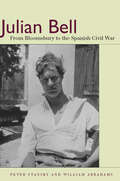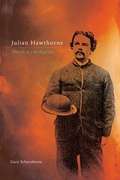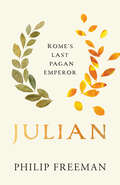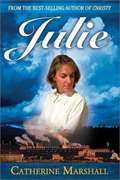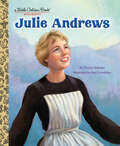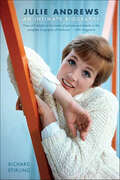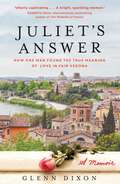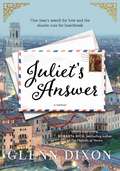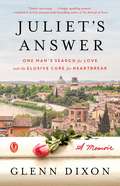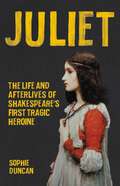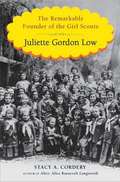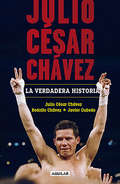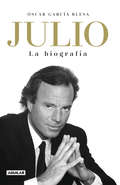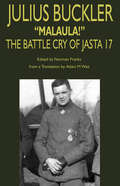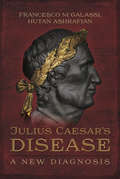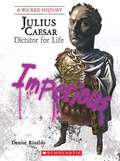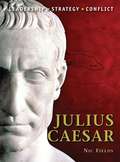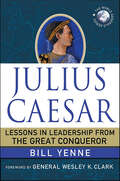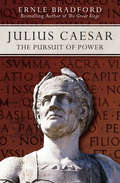- Table View
- List View
Julian Bell
by William Abrahams Peter StanskyJulian Bell explores the life of a younger member, and sole poet, of the Bloomsbury Group, the most important community of British writers and intellectuals in the twentieth century, which includes Virginia Woolf (Julian's aunt), E. M. Forster, the economist John Maynard Keynes, and the art critic Roger Fry. This biography draws upon the expanding archives on Bloomsbury to present Julian's life more completely and more personally than has been done previously. It is an intense and profound exploration of personal, sexual, intellectual, political, and literary life in England between the two world wars. Through Julian, the book provides important insights on Virginia Woolf, his mother Vanessa Bell, and other members of the Bloomsbury Group. Taking us from London to China to Spain during its civil war, the book is also the ultimately heartbreaking story of one young man's life.
Julian Hawthorne: The Life of a Prodigal Son
by Gary ScharnhorstJulian Hawthorne (1846-1934), Nathaniel Hawthorne's only son, lived a long and influential life marked by bad circumstances and worse choices. Raised among luminaries such as Thoreau, Emerson, and the Beecher family, Julian became a promising novelist in his twenties, but his writing soon devolved into mediocrity. What talent the young Hawthorne had was spent chasing across the changing literary and publishing landscapes of the period in search of a paycheck, writing everything from potboilers to ad copy. Julian was consistently short of funds because--as biographer Gary Scharnhorst is the first to reveal--he was supporting two households: his wife in one and a longtime mistress in the other. The younger Hawthorne's name and work ethic gave him influence in spite of his haphazard writing. Julian helped to found Cosmopolitan and Collier's Weekly. As a Hearst stringer, he covered some of the era's most important events: McKinley's assassination, the Galveston hurricane, and the Spanish-American War, among others. When Julian died at age 87, he had written millions of words and more than 3,000 pieces, out-publishing his father by a ratio of twenty to one. Gary Scharnhorst, after his own long career including works on Mark Twain, Oscar Wilde, and other famous writers, became fascinated by the leaps and falls of Julian Hawthorne. This biography shows why.
Julian of Norwich: Revelations of Divine Love
by Elizabeth Spearing Julian Of NorwichFrom the book: The showings were so compelling and so rich in meaning that Julian understood them to come directly from God and to be messages not just to herself but to all Christians. This led her to put them in writing and to convey her sense of their significance, as it was revealed in the course of many years of meditation, renewed by 'flashes of illumination and touches, I hope, of the same spirit which was shown in them all' (chapter 65). One supplementary showing came 'fifteen years and more later' - that is, about 1388 - and this she recounts in the final chapter of LT: [long text] it was that God's meaning in the whole series of experiences from 1373 was no more nor less than love. Julian wrote for private readers; they rather than listeners would have needed the list of contents in chapter 1 of LT and the summaries heading the other chapters (if these are authorial). Her target audience was initially 'all men and women who wish to lead the contemplative life' (ST [short text] chapter 4), but in LT she drops this limitation and seems to envisage a broader public of devout laypeople - a public that was on the increase in her lifetime. Since her work was adapted into modern English in 1901, her readership has expanded to far greater numbers than could have known it in earlier times. Both texts are included.
Julian: Rome's Last Pagan Emperor (Ancient Lives)
by Philip FreemanThe tragic life of Julian, the last non-Christian emperor of Rome, by award-winning author Philip Freeman Flavius Claudius Julianus, or Julian the Apostate, ruled Rome as sole emperor for just a year and a half, from 361 to 363, but during that time he turned the world upside down. Although a nephew of Constantine the Great, the first Christian emperor of Rome, Julian fought to return Rome to the old gods who had led his ancestors to build their vast empire. As emperor, Julian set about reforming the administration, conquering new territories, and reviving ancient religions. He was scorned in his time for repudiating Christianity and demonized as an apostate for willfully rejecting Christ. Through the centuries, Julian has been viewed by many as a tragic figure who sought to save Rome from its enemies and the corrupting influence of Christianity. Christian writers and historians have seen Julian much differently: as a traitor to God and violent oppressor of Christians. Had Julian not been killed by a random Persian spear, he might well have changed all of history.
Julie
by Catherine MarshallJulie Wallace was only eighteen when her family moved to a flood- prone Pennsylvania town in 1934. Here her father, risking their life savings, took over a struggling newspaper, and Julie began fighting to fulfill her dreams. She found herself taking sides as battle lines were drawn between desperate steelworkers and the owners of the mills- and being torn as two young men divided her loyalty and her heart. Then a devastating catastrophe became the ultimate test of courage and commitment-and Julie's special strength would come from love.
Julie Andrews: A Little Golden Book Biography (Little Golden Book)
by Christy WebsterHelp your little one dream big with a Little Golden Book biography about Julie Andrews, the beloved award-winning actress and singer! Little Golden Book biographies are the perfect introduction to nonfiction for preschoolers.This Little Golden Book about Dame Julie Andrews--Broadway icon, film star, and author--is a great read-aloud for young children as well as their parents and grandparents. Her iconic roles in My Fair Lady, Mary Poppins, Cinderella, and The Sound of Music make her a household name for all ages!Look for Little Golden Book biographies about these other inspiring people: Lucille BallQueen Elizabeth IIDolly PartonMisty CopelandBetty WhiteFrida KahloRuth Bader GinsburgJackie RobinsonMartin Luther King Jr.Carol BurnettWillie NelsonBeyoncéHarry BelafonteBob RossDwayne JohnsonTaylor SwiftSimone BilesIris ApfelTony Bennett
Julie Andrews: An Intimate Biography
by Richard StirlingJulie Andrews is the last of the great Hollywood musical stars, unequaled by any in her time. In My Fair Lady, Julie Andrews had the biggest hit on Broadway. As the title character in Mary Poppins, she won an Academy Award. And, in 1965, The Sound of Music made her the most famous woman in the world and rescued Twentieth Century Fox from bankruptcy. Three years later, the disastrous Star! almost put the studio back under, and the leading lady of both films fell as spectacularly as she had risen. Her film career seemed over. Yet Julie Andrews survived, with what Moss Hart, director of My Fair Lady, called 'that terrible British strength that makes you wonder why they lost India.' Victor/Victoria, directed by her second husband, Blake Edwards, reinvented her screen image--but its stage version in 1997 led to the devastating loss of her defining talent, her singing voice. Against all odds, she has fought back again, with leading roles in The Princess Diaries and Shrek 2. The real story of bandy-legged little Julia Wells from Walton-on-Thames is even more extraordinary; fresh details of her family background have only recently come to light. This is the first completely new biography of Julie Andrews as artist, wife, and mother in over thirty-five years--combining the author's interviews with the star and his wide-ranging and riveting research. It is a frank but affectionate portrait of an enduring icon of stage and screen, who was made a Dame in the Millennium Honours List. Once dubbed 'the last of the really great broads' by Paul Newman, she was the only actress in the 2002 BBC poll The 100 Greatest Britons. But who was Dame Julie, and who is she now? This is her story.
Julie Andrews: An Intimate Biography
by Richard StirlingJulie Andrews is the last of the great Hollywood musical stars, unequaled by any in her time.In My Fair Lady, Julie Andrews had the biggest hit on Broadway. As the title character in Mary Poppins, she won an Academy Award. And, in 1965, The Sound of Music made her the most famous woman in the world and rescued Twentieth Century Fox from bankruptcy. Three years later, the disastrous Star! almost put the studio back under, and the leading lady of both films fell as spectacularly as she had risen.Her film career seemed over.Yet Julie Andrews survived, with what Moss Hart, director of My Fair Lady, called "that terrible British strength that makes you wonder why they lost India." Victor/Victoria, directed by her second husband, Blake Edwards, reinvented her screen image---but its stage version in 1997 led to the devastating loss of her defining talent, her singing voice.Against all odds, she has fought back again, with leading roles in The Princess Diaries and Shrek 2. The real story of bandy-legged little Julia Wells from Walton-on-Thames is even more extraordinary; fresh details of her family background have only recently come to light.This is the first completely new biography of Julie Andrews as artist, wife, and mother in over thirty-five years---combining the author's interviews with the star and his wide-ranging and riveting research. It is a frank but affectionate portrait of an enduring icon of stage and screen, who was made a Dame in the Millenium Honours List. Once dubbed "the last of the really great broads" by Paul Newman, she was the only actress in the 2002 BBC poll The 100 Greatest Britons. But who was Dame Julie, and who is she now?This is her story.
Julie Walters: Seriously Funny - An Unauthorised Biography
by Lucy Ellis Bryony SutherlandFrom her BAFTA-winning television work, such as My Beautiful Son, to her big screen debut alongside Michael Caine in Educating Rita, her starring in Billy Elliot (both of which earned her Oscar nominations) and her portrayal of Mrs Weasley in the Harry Potter films, Julie Walters has worked with some of the greatest and most diverse actors and directors in the world today. In December 2005, at the British Comedy Awards, Walters - alongside longtime friend and television comedy partner Victoria Wood - picked up the Outstanding Contribution to Comedy Award.Raised in a strict Catholic family in working class Birmingham, Julie Walters abandoned a nursing course to study drama at Manchester Polytechnic and went on to join the Liverpool Everyman Theatre where she cut her teeth as an actress. Over the next decade, she experienced three marriage proposals, two long-term romances and a period of heavy drinking. At the end of 1984 she met sociology student Grant Roffey and had a daughter Maisie, who was traically diagnosed with luekaemia and had to undergo years of painful chemotherapy.the authors have interviewed friends, teachers and colleagues to skilfully compile the first-ever biography of one of Britain's finest and best-loved actresses.
Julie and Julia: 365 Days, 524 Recipes, 1 Tiny Apartment Kitchen
by Julie PowellJulie Powell is 30 years old, living in a rundown apartment in Queens and working at a secretarial job that's going nowhere. She needs something to break the monotony of her life, and she invents a deranged assignment. She will cook all 524 recipes in Julia Child's 1961 classic Mastering the Art of French Cooking. In the span of one year. At first she thinks it will be easy, but as she moves from simple potato soup into more complicated realms, she realizes there's more to Mastering the Art than meets the eye. She haunts the local butcher, buying kidneys and sweetbreads. She rarely serves dinner before midnight. She discovers how to mold the perfect Orange Bavarian, the trick to extracting marrow from bone, and the intense pleasure of eating liver. And somewhere along the line she realizes she has eclipsed her life's ordinariness through humor, hysteria, and perseverance.
Juliet's Answer
by Glenn DixonIn fair Verona, where we lay our scene ...When Glenn Dixon is spurned by love, he packs his bags for Verona, the setting for Shakespeare's most famous love story, Romeo and Juliet. Determined to heal his heartbreak by helping others, he becomes the lone male in a dedicated team of secretaries who answer letters from thousands of lovelorn people around the world on behalf of 'Juliet'. Although he has firsthand experience of heartbreak and has taught Shakespeare for decades, at first Glenn struggles with how he can advise others yearning to understand the mysteries of the heart. But as he learns from his fellow letter writers about life and love, he comes to realise he has a lot of learning to do about himself, about heartbreak - and about Shakespeare's two fictional lovers. He also learns that the letters have the power to transform lives, his own included. An irresistible modern-day love story set against the backdrop of one of the most enduring love stories of all time, Juliet's Answer will warm your heart long after the last page.
Juliet's Answer: One Man's Search for Love and the Elusive Cure for Heartbreak
by Glenn DixonEat, Pray, Love (from a man’s perspective) meets Under the Tuscan Sun—a fresh, heartwarming story about a man who travels to Verona, where he answers letters addressed to Shakespeare’s Juliet, all in an attempt to understand heartbreak, to heal and to find love again.In fair Verona where we lay our scene… When Glenn Dixon is spurned by love, he does something unusual. He travels to Verona, Italy, to become a scribe of Juliet, Shakespeare’s fictional character, all in an attempt to understand his heartbreak. Once there, he volunteers to answer the thousands of letters that arrive addressed to Juliet, letters sent from lovelorn people all over the world who long to understand the mysteries of the human heart. Glenn’s journey takes him deep into the charming community of Verona, where he learns the traditions of the townspeople and becomes involved in unravelling the truth behind Romeo and Juliet—Did these star-crossed lovers actually exist? Did they live in Verona? Why have they remained at the forefront of hearts and minds for centuries? And what can they teach us about love? At the same time, we learn about Claire, Glenn’s unrequited love, the source of his heartbreak. Was she truly his soul’s match, or was she, like Rosalind in Shakespeare’s classic play, a mere infatuation who pales in comparison the moment his real Juliet enters his life? When Glenn returns home to Canada and resumes his duties as a Grade 10 English teacher, he undertakes a lively reading of Romeo and Juliet with his students, engaging them in passions past and present. But in an intriguing reversal of fate and fortune, his students—along with an old friend—instruct the teacher on the true meaning of love, loss, and moving on. An enthralling tale of modern-day love steeped in the romantic traditions of eras past, this is a memoir that will warm your heart.
Juliet's Answer: One Man's Search for Love and the Elusive Cure for Heartbreak
by Glenn DixonEat, Pray, Love meets The Rosie Project in this fresh, heartwarming memoir by a man who travels to Verona and volunteers to answer letters addressed to Shakespeare’s Juliet, all in an attempt to heal his own heartbreak.When Glenn Dixon is spurned by love, he packs his bags for Verona, Italy. Once there, he volunteers to answer the thousands of letters that arrive addressed to Juliet—letters sent from lovelorn people all over the world to Juliet’s hometown; people who long to understand the mysteries of the human heart. Glenn’s journey takes him deep into the charming community of Verona, where he becomes involved in unraveling the truth behind Romeo and Juliet. Did these star-crossed lovers actually exist? Why have they remained at the forefront of hearts and minds for centuries? And what can they teach us about love? When Glenn returns home to Canada and resumes his duties as an English teacher, he undertakes a lively reading of Romeo and Juliet with his students, engaging them in passions past and present. But in an intriguing reversal of fate and fortune, his students—along with an old friend—instruct the teacher on the true meaning of love, loss, and moving on. An enthralling tale of modern-day love steeped in the romantic traditions of eras past, this is a memoir that will warm your heart.
Juliet: The Life and Afterlives of Shakespeare's First Tragic Heroine
by Sophie DuncanThe enduring cultural legacy of Shakespeare&’s Juliet Capulet — a history "as vital and provocative as the character herself" (Literary Review).Romeo and Juliet may be the greatest love story ever told, but who is Juliet? Demure ingénue? Or dangerous Mediterranean madwoman? From tearstained copies of the First Folio to Civil War-era fanfiction, Shakespeare&’s star-crossed heroine has long captured our collective imagination. Juliet is her story, traced across continents through four centuries of history, theatre, and film. As Oxford Shakespeare scholar Sophie Duncan reveals, Juliet&’s legacy stretches beyond her literary lifespan into a cultural afterlife ranging from enslaved African girls in the British Caribbean to the real-life Juliets of sectarian violence in Bosnia and Belfast. She argues that our dangerous obsession with the beautiful dead teenager and Juliet&’s meteoric rise as a defiant sexual icon have come to define the Western ideal of romance. Wry and inventive, Juliet is a tribute to fiction&’s most famous teenage girl who died young, but who lives forever.
Juliette Gordon Low: America's First Girl Scout
by Kathleen V. KudlinskiPresents a biography of the founder of the Girl Scout movement.
Juliette Gordon Low: The Remarkable Founder of the Girl Scouts
by Stacy A. CorderyBorn at the start of the Civil War, Juliette "Daisy" Gordon Low struggled to reconcile being a good Southern belle with being true to her adventurous spirit. Accidentally deafened, she married a dashing British patrician and moved to England, where she quickly became dissatisfied with the aimlessness of privileged life. Her search for greater purpose ended when she met Robert Baden-Powell, founder of the Boy Scouts, and was inspired to recreate his program for girls. The Girl Scouts of the USA—which can now count more than fifty-nine million American girls and women among its past members—aims to instill useful skills and moral values in its young members, with an emphasis on fun. In this lively and accessible biography of its intrepid founder, Stacy A. Cordery paints a dynamic portrait of an intriguing woman and a true pioneer whose work touched the lives of millions of girls and women around the world. .
Julio César Chávez: la verdadera historia
by Julio César Chávez Rodolfo Chávez Javier CubedoEn estas páginas sin censura se cuenta todo sobre la vida intensa, de esplendor y tragedia, del mejor boxeador que ha tenido México y uno de los campeones mundiales más grandes de todos los tiempos De niño, Julio César Chávez vivió con sus padres y hermanos en un viejo vagón de tren, en la pobreza más extrema; desde sus primeras peleas profesionales sorprendió de inmediato a los expertos; sus victorias ante rivales duros y experimentados -a veces sin ganar un solo peso por sus combates- le dieron la oportunidad de llegar al ansiado título del mundo, para con ello iniciar su leyenda. Jamás se había escrito con tanta franqueza sobre sus logros como boxeador, sus peleas por los campeonatos mundiales, sus enfrentamientos legendarios con Mario El Azabache Martínez, Rubén Castillo, Edwin El Chapo Rosario, Roger Mayweather, Meldrick Taylor, Óscar de la Hoya y muchos más peleadores fuera de serie; su incursión en el mundo del alcohol, las drogas, el torbellino de una vida al límite que derivó en las derrotas más trágicas de su vida. Julio César Chávez: la verdadera historia revela quiénes fueron los grandes amores del campeón mexicano; qué actrices, cantantes y celebridades fueron seducidas por su carisma; cuál fue su relación con políticos poderosos, presidentes del país, empresarios, narcos encumbrados y estrellas del espectáculo. El testimonio del gran campeón mexicano y del hermano mayor de El César del boxeo, recogido por Javier Cubedo, no sólo es el repaso de una vida intensa y delirante, es también una serie inolvidable de lecciones de vida, un recuento de las victorias en el ring, de los romances prohibidos y las confesiones de esas horas de excesos demenciales, sin olvidar las trágicas muertes de los hermanos del campeón mexicano y los detalles donde se da muestra de la generosidad del campeón con su familia y la gente del pueblo que, sin duda, lo hizo ya inmortal.
Julio Iglesias. La biografía
by Óscar García BlesaSemblanza del artista español más influyente de las últimas 5 décadas. En la noche que cumplía veinte años, un accidente de coche en una carretera de Madrid cambió para siempre la vida de un joven lleno de sueños. Aquel muchacho, inmóvil durante más de un año y medio en una cama de hospital, se abrazó a una guitarra como única válvula de escape. Desde su cama, sin saberlo, Julio Iglesias construiría una de las historias de conquista global más fascinantes del siglo XX. La vida de Julio Iglesias es mucho más que una colección de efemérides y cifras, es una historia de superación, amor, fama, éxito y redención. Su carrera no es solo el relato de su inigualable triunfo y reinvención, es también la crónica sociocultural de todo un país a lo largo de más de setenta años. En 2019 se cumplen 50 años del debut discográfico de Julio Iglesias. Recabando datos de su trayectoria personal y profesional, Óscar García Blesa reúne todas las piezas de un puzle vital, un repaso por las luces y las sombras de su historia, una vida intensa como la letra de muchas de sus canciones. Julio es la crónica emocional, cultural y sentimental de un artista único que nunca ha abandonado los escenarios y que no tiene intención de hacerlo mientras viva.
Julius Buckler: The Battle Cry of Jasta 17
by Norman FranksThe memoir of a German fighter ace that gives a much-needed perspective on what it was like to fight for the Central Powers during World War I. This important work was first published in German in late 1939, no doubt timed to impress the young Luftwaffe fighter pilots who were embarking on the second major air war in history. Buckler initially served with the army when the Great War began, until he was wounded and moved to the air service to train as a pilot. Following a baptism of fire flying two-seat reconnaissance missions over France, he became a fighter pilot, joining Jasta 17 in late 1916. Despite receiving several more wounds, he continued in action, finally being awarded the highest decoration of the Pour le Mérite and ending the war with 36 victories over British and French aircraft. Not so much a war diary, his book is more a collection of memories told in a refreshing and entertaining manner. Renowned air historian Norman Franks has placed these in context and added accurate and authenticated details of what Buckler achieved. However, the fighter ace&’s original words remain largely unchanged, and Adam Wait&’s expert translation gives a valuable insight into what it was like to fly over the Western Front from the other side of the line.&“A well rounded, thorough investigation of a topic that would otherwise have remained unknown to most American readers . . . superior and highly recommended.&” —Indy Squadron Dispatch
Julius Caesar (Gift for History Buffs)
by Philip FreemanA fascinating, comprehensive biography of the cunning Roman conqueror Julius Caesar.More than two thousand years after his death, Julius Caesar remains one of the great figures of history. He shaped Rome for generations, and his name became a synonym for &“emperor&”—not only in Rome but as far away as Germany and Russia. He is best known as the general who defeated the Gauls and doubled the size of Rome&’s territories. But, as Philip Freeman describes in this fascinating new biography, Caesar was also a brilliant orator, an accomplished writer, a skilled politician, and much more. Julius Caesar was a complex man, both hero and villain. He possessed great courage, ambition, honor, and vanity. Born into a noble family that had long been in decline, he advanced his career cunningly, beginning as a priest and eventually becoming Rome&’s leading general. He made alliances with his rivals and then discarded them when it suited him. He was a spokesman for the ordinary people of Rome, who rallied around him time and again, but he profited enormously from his conquests and lived opulently. Eventually he was murdered in one of the most famous assassinations in history. Caesar&’s contemporaries included some of Rome&’s most famous figures, from the generals Marius, Sulla, and Pompey to the orator and legislator Cicero as well as the young politicians Mark Antony and Octavius (later Caesar Augustus). Caesar&’s legendary romance with the Egyptian queen Cleopatra still fascinates us today. In this splendid biography, Freeman presents Caesar in all his dimensions and contradictions. With remarkable clarity and brevity, Freeman shows how Caesar dominated a newly powerful Rome and shaped its destiny. This book will captivate readers discovering Caesar and ancient Rome for the first time as well as those who have a deep interest in the classical world.
Julius Caesar's Disease: A New Diagnosis
by Hutan Ashrafian Francesco M. GalassiIn this groundbreaking study, two medical historians present a provocative new diagnosis of the ailment that famously afflicted Julius Caesar. It is generally accepted as a historical fact that Julius Caesar suffered from epilepsy, an illness which in classical times was sometimes associated with divinely bestowed genius. The ancient sources describe several episodes when, sometimes at critical junctures, one of the most accomplished military commanders in history was incapacitated by a condition referred to as morbus comitialis. But does the evidence of his illness really suggest a diagnosis of epilepsy? And if it was not epilepsy that afflicted Caesar, what was it? These are the questions that doctors Francesco M. Galassi and Hutan Ashrafian seek to answer by applying modern medical knowledge to the symptoms and circumstances described by primary source documents—including statements made by Caesar himself. The result is a fascinating piece of historical-pathological detective work that challenges received wisdom about one of the most famous men of all time.
Julius Caesar: Dictator for Life (A Wicked History)
by Denise RinaldoTraces the life of Julius Caesar, including his childhood, education, military conquests, and assassination.
Julius Caesar: Leadership, Strategy, Conflict
by Nic FieldsOne of the greatest military commanders in history, Julius Caesar's most famous victory - the conquest of Gaul - was to him little more than a steppingstone to power. An audacious and decisive general, his victories over the Gauls allowed him to challenge for the political leadership of Rome. Leading a single legion across the Rubicon in 49 BC, Caesar launched a civil war which would end the Roman Republic and usher in the Roman Empire, with Caesar at its helm. This examination of the great general's life covers his great victories and few defeats, looking at the factors which lay behind his military genius.
Julius Caesar: Lessons in Leadership from the Great Conqueror (World Generals Series)
by Bill YenneNo ancient ruler inspired more legends than Julius Caesar. Under his leadership, Rome conquered territory throughout Europe and the Mediterranean, reaching the North Sea and conducting the first Roman invasion of Great Britain. His tactical acumen and intuitive understanding of how armies work birthed a military structure that allowed Roman generals to expand the boundaries of the empire for generations, and his vision of a unified Europe inspired military leaders for hundreds of years. Yet, in addition to his commanding leadership of Roman troops, Caesar was also a gifted orator and skilled politician who successfully maneuvered within the most complex and well-established bureaucratic system in the world. In this fast-paced look at one of the greatest generals the world has ever seen, acclaimed author Bill Yenne charts the major events that shaped Caesar's leadership, his rise to power, and his crashing fall.
Julius Caesar: The Pursuit of Power
by Ernle BradfordThe epic life story of the Roman statesman, military commander, and dictator, from the bestselling author of Thermopylae. Born to Roman aristocracy in 100 BC, Julius Caesar became one of the most powerful men in history. He was a military genius, a fierce politician, and a brilliant writer and orator. When he formed an alliance with Pompey and Crassus, the triumvirate of officials took control of the Roman Republic. But Caesar&’s quest for power was only beginning. As proconsul, he went to war against the Gallic tribes of the north, extending Roman territory into Gaul, Belgium, Germany, and Britain. When the Gallic Wars ended, the Roman senate called on Caesar to return to private life. But rather than relinquish his title, Caesar led his legion into a civil war that would spell the end of the Roman Republic and the beginning of the Roman Empire. In this thrilling and thoroughly researched biography, Ernle Bradford cuts through the legends in order to present a truthful and nuanced portrait of a man whose pursuit of power knew no bounds.
